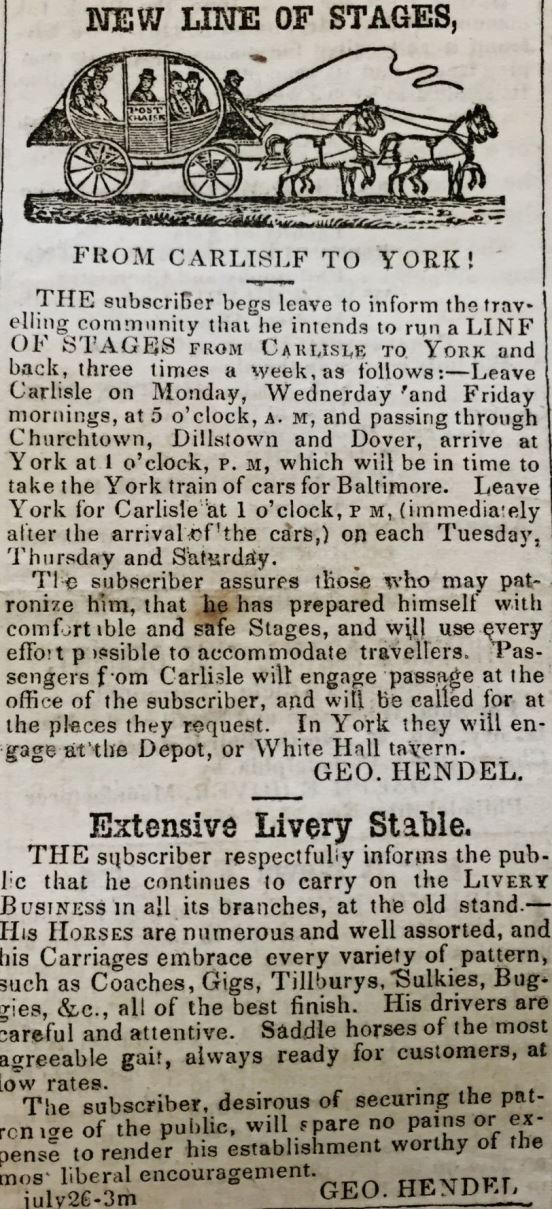The son of Carlisle silversmith George Hendel and his wife Rosanna Jumper, George Hendel, Jr. was born on August 20, 1815. He did not follow his father’s profession, and by 1837 he was in the livery business with James Gaulagher. Their partnership was short-lived, but they were assessed in 1838 as “Hendel & Gaulagher Livery Stable” with one old four-wheel carriage, one new two-horse Barouche, two Tilberry’s, two gigs, one sulky and seven horses.1
Expanding his business in the summer of 1848, Hendel advertised that he intended to run a line of stages from Carlisle to York and back three times a week.2 Business was obviously good, and by the summer of 1850 he was running daily stages from Carlisle to York. They left Carlisle at 6 A.M. and arrived in York at 1 P.M. in time for the 2 o’clock train to Baltimore.3 He employed coach drivers Jacob Keeny, aged 19; David Lenhart, aged 30; and John Erb aged 25.4 Hendel advertised that his coaches “were new and comfortable,” and that his “stock had recently been much improved.”5
Disaster struck Hendel on the night of March 28, 1854 when a horrendous, wind-driven fire consumed seven buildings in Carlisle. It started in a small shed in the rear of Hendel’s livery stable on the corner of Pomfret and Pitt streets.6 Hendel’s large livery establishment, blacksmith shop, etc. on South Pitt street as well as his dwelling and tenant houses on West Pomfret Street were entirely consumed. There was very little, if any, insurance.7 The Town Council offered a reward of $150 for any information that would lead to the arrest and conviction of the person who set fire to Hendel’s stable.8 Hendel recovered somewhat, and was still running a livery stable in 1860, but by 1870 his occupation was given on the U. S. Census as a stock dealer.
Hendel and his wife Harriet were childless. His wife Harriet died on May 12, 1872 and is buried in Carlisle’s Old Graveyard next to her husband George who died on August 1, 1876.
Hendel was remembered long after his death by many of the townspeople. “Of course everybody knew “Dorsey” Hendel, the best-natured person imaginable,” Charles Leeds wrote of Hendel in 1909. “You remember that laugh, peculiarly his own; it was known as well in Harrisburg, Lancaster and Philadelphia as in Cumberland County.”9
Reverend Joseph Martin wrote about an incident involving Hendel in an article in the March 1, 1882 edition of the American Volunteer newspaper titled “Reminiscences of Churches of the 1850s.”
“The winter of 1857 was remarkable for two events, the great panic and the revival. The Cumberland Valley, from Harrisburg to Chambersburg, was all aflame. For about a month, little else was done in your town but attend meetings. All classes were interested, and men who had been known as quiet, unobtrusive citizens came to the front as evangelists. The old church was on fire. Jake Hipple, ‘Small’ Weirich, all the Swartzes, and most everybody else professed ‘conversion.’ Dorsey Hendel, John Nobel, and Jim Moudy were reported ‘serious.’ A committee was appointed to see Messrs. Hendel and Noble. That most excellent man Robert Moore was the chairman…The committee made a big report on Mr. Hendel’s case. They found him at his place of business, and had a conversation with him...One of the men in Mr. Hendel’s employ gave some points of the interview.
Mr. Hendel invited the gentlemen into his office and Mr. (Robert) Moore began in a very solemn way to state the object of their visit. Mr. H. listened and seemed overcome, putting his head down into his hands. Suddenly he burst out in his peculiar, indescribable, mirth producing laugh, and peel after peel and roll after roll succeeded each other. The committee rose to go when Mr. H. said to Mr. Moore, ‘excuse me Bob, but I couldn’t help it. I have known you Bob for 20 years, and believe in you, but I ain’t in any more danger now than any time in 30 years, and you never spoke to me about it before,” and then his laugh came back, and held him until exhausted...”


